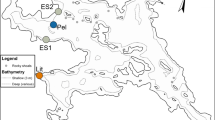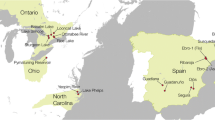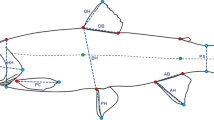Abstract
Non-indigenous species are oftentimes exposed to ecosystems with unfamiliar species, and organisms that exhibit a high degree of phenotypic plasticity may be better able to contend with the novel competitors that they may encounter during range expansion. In this study, differences in morphological plasticity were investigated using young-of-year pumpkinseed sunfish (Lepomis gibbosus) from native North American and non-native European populations. Two Canadian populations, isolated from bluegill sunfish (L. macrochirus) since the last glaciation, and two Spanish populations, isolated from bluegill since their introduction in Europe, were reared in a common environment using artificial enclosures. Fish were subjected to allopatric (without bluegill) or sympatric (with bluegill) conditions, and differences in plasticity were tested through a MANOVA of discriminant function scores. All pumpkinseed populations exhibited dietary shifts towards more benthivorous prey when held with bluegill. Differences between North American and European populations were observed in body dimensions, gill raker length and pelvic fin position. Sympatric treatments induced an increase in body width and a decrease in caudal peduncle length in native fish; non-native fish exhibited longer caudal peduncle lengths when held in sympatry with bluegill. Overall, phenotypic plasticity influenced morphological divergence less than genetic factors, regardless of population. Contrary to predictions, pumpkinseeds from Europe exhibited lower levels of phenotypic plasticity than Canadian populations, suggesting that European pumpkinseeds are more canalized than their North American counterparts.




Similar content being viewed by others
References
Arbour JH, Hardie DC, Hutchings JA (2010) Morphometric and genetic analyses of two sympatric morphs of Arctic char (Salvelinus alpinus) in the Canadian High Arctic. Can J Zool 89:19–30
Arendt JD, Wilson DS (1997) Optimistic growth: competition and an ontogenetic niche-shift select for rapid growth in pumpkinseed sunfish (Lepomis gibbosus). Evolution 51:1946–1954
Arendt JD, Wilson DS (1999) Countergradient selection for rapid growth in pumpkinseed sunfish: disentangling ecological and evolutionary effects. Ecology 80:2793–2798
Auld JR, Relyea RA (2010) Inbreeding depression in adaptive plasticity under predation risk in a freshwater snail. Biol Lett 6:222–224
Bhagat Y, Fox MG, Ferreira MT (2006) Morphological differentiation in introduced pumpkinseed Lepomis gibbosus (L.) occupying different habitat zones in Portuguese reservoirs. J Fish Biol 69:79–94
Bhagat Y, Fox MG, Ferreira MT (2011) Trophic polymorphism in introduced pumpkinseed (Lepomis gibbosus) inhabiting Iberian reservoirs. Environ Biol Fish 91:203–217
Brabrand Å (1985) Food of roach (Rutilus rutilus) and ide (Leusiscus idus): significance of diet shift for interspecific competition in omnivorous fishes. Oecologia 66:461–467
Caño L, Escarré J, Fleck I, Blanco-Moreno JM, Sans FX (2008) Increased fitness and plasticity of an invasive species in its introduced range: a study using Senecia pterophorus. J Ecol 96:468–476
Chown SL, Slabber S, McGeoch MA, Janion C, Leinaas HP (2007) Phenotypic plasticity mediates climate change responses among invasive and indigenous arthropods. Proc R Soc B Biol Sci 274:2531–2537
Chun YJ (2011) Phenotypic plasticity of introduced versus native purple loosestrife: univariate and multivariate reaction norm approaches. Biol Invasions 13:819–829
Clavero M, Blanco-Garrido F, Prenda J (2004) Fish fauna in Iberian Mediterranean river basins: biodiversity, introduced species and damming impacts. Aquat Conserv 14:575–585
Clavero M, Hermoso V, Aparicio E, Godinho FN (2013) Biodiversity in heavily modified waterbodies: native and introduced fish in Iberian reservoirs. Freshw Biol 58:1190–1201
Copp GH, Fox MG (2007) Growth and life history traits of introduced pumpkinseed (Lepomis gibbosus) in Europe, and the relevance to its potential invasiveness. In: Gherardi F (ed) Biological invaders in inland waters: profiles, distribution, and threats. Springer, Dordrecht, pp 289–306
Crispo E (2007) The Baldwin effect and genetic assimilation: revisiting two mechanisms of evolutionary change mediated by phenotypic plasticity. Evolution 61:2469–2479
Crossin GT, Hinch SG, Farrell AP, Higgs DA, Lotto AG, Oakes JD, Healey MC (2004) Energetics and morphology of sockeye salmon: effects of upriver migratory distance and elevation. J Fish Biol 65:788–810
Davidson AM, Jennions M, Nicotra AB (2011) Do invasive species show higher phenotypic plasticity than native species and, if so, is it adaptive? A meta-analysis. Ecol Lett 14:419–431
Day T, Pritchard J, Schluter D (1994) A comparison of two sticklebacks. Evolution 48:1723–1734
Ehlinger TJ, Wilson DS (1988) Complex foraging polymorphism in bluegill sunfish. Proc Natl Acad Sci U S A 85:1878–1882
Elvira B, Almodóvar A (2001) Freshwater fish introductions in Spain: facts and figures at the beginning of the 21st century. J Fish Biol 59:323–331
Firbank LG, Watkinson AR (1985) On the analysis of competition within two-species mixtures of plants. J Appl Ecol 22:503–517
Fox MG, Vila-Gispert A, Copp GH (2007) Life-history traits of introduced Iberian pumpkinseed Lepomis gibbosus relative to native populations. Can differences explain colonization success? J Fish Biol 71:56–69
Frankham R (1996) Relationship of genetic variation to population size in wildlife. Conserv Biol 10:1500–1508
Fraser DJ, Weir LK, Bernatchez L, Hansen MM, Taylor EB (2011) Extent and scale of local adaptation in salmonid fishes: review and meta-analysis. Heredity 106:404–420
García-Berthou E, Moreno-Amich R (2000) Introduction of exotic fish into a Mediterranean lake over a 90-year period. Arch Hydrobiol 149:271–284
Ghalambor CK, McKay JK, Carroll SP, Reznick DN (2007) Adaptive versus non-adaptive phenotypic plasticity and the potential for contemporary adaptation in new environments. Funct Ecol 21:394–407
Gillespie GJ, Fox MG (2003) Morphological and life history differentiation between littoral and pelagic forms of pumpkinseed. J Fish Biol 62:1099–1115
Godinho F, Ferreira MT, Cortes RV (1997) The environmental basis of diet variation in pumpkinseed sunfish, Lepomis gibbosus, and largemouth bass, Micropterus salmoides, along an Iberian river basin. Environ Biol Fish 50:105–115
Hanson JM, Leggett WC (1986) Effect of competition between two freshwater fishes on prey consumption and abundance. Can J Fish Aquat Sci 43:1363–1372
Hegrenes S (2001) Diet-induced phenotypic plasticity of feeding morphology in the orangespotted sunfish, Lepomis humilis. Ecol Freshw Fish 10:35–42
Higham TE (2007) Feeding, fins and braking maneuvers: locomotion during prey capture in centrarchid fishes. J Exp Biol 210:107–117
Jastrebski CJ (2001) Divergence and selection in trophically polymorphic pumpkinseed sunfish (Lepomis gibbosus). PhD thesis. University of Guelph, Guelph
Kahilainen KK, Siwertsson A, Gjelland KØ, Knudsen R, Bøhn T, Amundsen PA (2011) The role of gill raker number variability in adaptive radiation of coregonid fish. Evol Ecol 25:573–588
Keast A (1978) Feeding interrelations between age-groups of pumpkinseed (Lepomis gibbosus) and comparisons with bluegill (L. macrochirus). J Fish Res Board Can 35:12–27
Keast A (1980) Food and feeding relationships of young fish in the first weeks after the beginning of exogenous feeding in Lake Opinicon, Ontario. Environ Biol Fish 5:305–314
Kolar CS, Lodge DM (2001) Progress in invasion biology: predicting invaders. Trends Ecol Evol 16:199–204
Kolbe JJ, Glor RE, Schettino LR, Lara AC, Larson A, Losos JB (2004) Genetic variation increases during biological invasion by a Cuban lizard. Nature 431:177–181
Levins R (1968) Evolution in changing environments. Princeton Univ Press, Princeton
Liso S, Gjelland KØ, Reshetnikov YS, Amundsen PA (2011) A planktivorous specialist turns rapacious: piscivory in invading vendace Coregonus albula. J Fish Biol 78:332–337
Magalhães MF (1993) Feeding of an Iberian stream cyprinid assemblage: seasonality of resource use in a highly variable environment. Oecologia 96:253–260
Mandrak NE, Crossman EJ (1992) Postglacial dispersal of freshwater fishes into Ontario. Can J Zool 70:2247–2259
Marchetti MP (1999) An experimental study of competition between the native Sacramento perch (Archoplites interruptus) and introduced bluegill (Lepomis macrochirus). Biol Invasions 1:55–65
Matesanz S, Gianoli E, Valladares F (2010) Global change and the evolution of phenotypic plasticity in plants. Ann N Y Acad Sci 1206:35–55
Matthews B, Marchinko KB, Bolnick DI, Mazumder A (2010) Specialization of trophic position and habitat use by sticklebacks in an adaptive radiation. Ecology 91:1025–1034
Messiaen M, Janssen CR, Thas O, De Schamphelaere KAC (2012) The potential for adaptation in a natural Daphnia magna population: broad and narrow-sense heritability of net reproductive rate under Cd stress at two temperatures. Ecotoxicology 21:1899–1910
Mittelbach GG (1984) Predation and resource partitioning in two sunfishes (Centrarchidae). Ecology 65:499–513
Mittelbach GG, Osenberg CW, Wainwright PC (1999) Variation in feeding morphology between pumpkinseed populations: phenotypic plasticity or evolution? Evol Ecol Res 1:111–128
Osenberg CW, Werner EE, Mittelbach GG, Hall DJ (1988) Growth patterns in bluegill (Lepomis macrochirus) and pumpkinseed (L. gibbosus) sunfish: environmental variation and the importance of ontogenetic niche shifts. Can J Fish Aquat Sci 45:17–26
Parsons KJ, Robinson BW (2006) Replicated evolution of integrated plastic responses during early adaptive divergence. Evolution 60:801–813
Parsons KJ, Robinson BW (2007) Foraging performance of diet-induced morphotypes in pumpkinseed sunfish (Lepomis gibbosus) favours resource polymorphism. J Evol Biol 20:673–684
Persson A, Brönmark C (2002) Foraging capacity and resource synchronization in an ontogenetic diet switcher, pikeperch (Stizostedion lucioperca). Ecology 83:3014–3022
Persson A, Hansson LA (1999) Diet shift in fish following competitive release. Can J Fish Aquat Sci 56:70–78
Reynolds HL (1999) Plant interactions: competition. In: Pugnaire F, Valladares F (eds) Handbook of functional plant ecology. Dekker, New York, pp 649–676
Robinson BW, Parsons KJ (2002) Changing times, spaces, and faces: tests and implications of adaptive morphological plasticity in the fishes of northern postglacial lakes. Can J Fish Aquat Sci 59:1819–1833
Robinson BW, Wilson DS (1996) Genetic variation and phenotypic plasticity in a trophically polymorphic population of pumpkinseed sunfish (Lepomis gibbosus). Evol Ecol 10:631–652
Robinson BW, Wilson DS, Margosian AS, Lotito PT (1993) Ecological and morphological differentiation of pumpkinseed sunfish in lakes without bluegill sunfish. Evol Ecol 7:451–464
Robinson BW, Wilson DS, Shea GO (1996) Trade-offs of ecological specialization: an intraspecific comparison of pumpkinseed sunfish phenotypes. Ecology 77:170–178
Robinson BW, Wilson DS, Margosian AS (2000) A pluralistic analysis of character release in pumpkinseed sunfish (Lepomis gibbosus). Ecology 81:2799–2812
Sagnes P, Champagne JY, Morel R (2000) Shifts in drag and swimming potential during grayling ontogenesis: relations with habitat use. J Fish Biol 57:52–68
Schleicherová D, Sella G, Lorenzi MC (2013) Do stable environments select against phenotypic plasticity in hermaphroditic sex allocation? Ital J Zool 80:358–363
Schluter D (1993) Adaptive radiation in sticklebacks: size, shape, and habitat use efficiency. Ecology 74:699–709
Scott WB, Crossman EJ (1973) Freshwater fishes of Canada. Fisheries Research Board of Canada. Ottawa, Ontario
Snaydon RW (1991) Replacement or additive designs for competition studies? J Appl Ecol 28:930–946
Springer VG, Johnson GD, Schaefer SA (2000) Use and advantages of ethanol solution of alizarin red S dye for staining bone in fishes. Copeia 2000:300–301
Strauss RE, Bookstein FL (1982) The truss: body form reconstructions in morphometrics. Syst Zool 31:113–135
Svanbäck R, Eklöv P (2002) Effects of habitat and food resources on morphology and ontogenetic growth trajectories in perch. Oecologia 131:61–70
Svanbäck R, Schluter D (2012) Niche specialization influences adaptive phenotypic plasticity in threespine stickleback. Am Nat 180:50–59
Svanbäck R, Eklöv P, Fransson R, Holmgren K (2008) Intraspecific competition drives multiple species resource polymorphism in fish communities. Oikos 117:114–124
Werner EE, Hall DJ (1976) Niche shifts in sunfishes: experimental evidence and significance. Science 191:404–406
Werner EE, Hall DJ (1977) Competition and habitat shift in two sunfishes (Centrarchidae). Ecology 58:869–876
Werner EE, Hall DJ (1979) Foraging efficiency and habitat switching in competing sunfishes. Ecology 60:256–264
Willi Y, Buskirk JV, Hoffmann AA (2006) Limits to the adaptive potential of small populations. Annu Rev Ecol Evol Syst 37:433–458
Yavno S, Fox MG (2013) Morphological change and phenotypic plasticity in native and non-native pumpkinseed sunfish in response to sustained water velocities. J Evol Biol 26:2383–2395
Yavno S, Fox MG, Vila-Gispert A, Bhagat Y (2013) Morphological differences between native and non-native pumpkinseed in traits associated with locomotion. Environ Biol Fish 96:507–518
Acknowledgments
We thank C. Corkery and his family for generously providing access to their pond, and D. Algera, J. Gobin, A. Istead, and L. Masson for their field assistance. We also thank three anonymous reviewers for providing constructive comments on an earlier draft of this paper. Funding was provided by the Natural Sciences and Engineering Research Council of Canada to MGF and by the Ontario Ministry of Training, Colleges and Universities in the form of Ontario Graduate Scholarships to SY and ACR.
Author information
Authors and Affiliations
Corresponding author
Additional information
Communicated by: Sven Thatje
Rights and permissions
About this article
Cite this article
Yavno, S., Rooke, A.C. & Fox, M.G. Morphological change and phenotypic plasticity in native and non-native pumpkinseed sunfish in response to competition. Naturwissenschaften 101, 479–492 (2014). https://doi.org/10.1007/s00114-014-1177-z
Received:
Revised:
Accepted:
Published:
Issue Date:
DOI: https://doi.org/10.1007/s00114-014-1177-z




